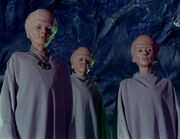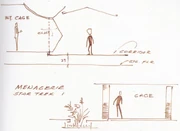No edit summary |
(→Background information: added some more info, re: set) |
||
| (16 intermediate revisions by 11 users not shown) | |||
| Line 1: | Line 1: | ||
| + | [[File:Talosians 3.jpg|thumb|Talosian observers]]__NOTOC__ |
||
| − | [[Image:Talosians_3.jpg|200px|right]] |
||
| − | |||
The '''Talosian menagerie''' was an elaborate test devised by the [[Talosian|inhabitants]] of the [[planet]] [[Talos IV]] to evaluate the intelligence and resourcefulness of specimens of intelligent life they had collected. |
The '''Talosian menagerie''' was an elaborate test devised by the [[Talosian|inhabitants]] of the [[planet]] [[Talos IV]] to evaluate the intelligence and resourcefulness of specimens of intelligent life they had collected. |
||
| − | The Talosians' ultimate aim was to find a species that could be bred to serve them by |
+ | The Talosians' ultimate aim was to find a [[species]] that could be bred to serve them by recolonizing the war-ravaged surface of their world. Test subjects were kept in small cells with large observation panels and fed with synthetic [[food]]. The Talosians were able to test the subjects' responses by a series of illusions and [[telepathy|telepathic]] tricks. It was hoped that subjects would discover a way to escape from their cage and make their way to the surface to begin cultivating it. |
| + | |||
| ⚫ | [[Captain]] [[Christopher Pike]] of the {{USS|Enterprise|NCC-1701}} was imprisoned in the menagerie in [[2254]]. Although he was able to "pass" the Talosians' test and escape to the surface, the Talosians came to the conclusion that [[Human]]s' hatred of captivity made the species unsuitable for their needs. ({{TOS|The Cage|The Menagerie, Part I|The Menagerie, Part II}}) |
||
| + | |||
| + | == Appendices == |
||
| + | === Related topics === |
||
| + | * [[Zoo]] |
||
| + | |||
| + | === Background information === |
||
| + | In the story outline for "The Cage" (as reprinted in ''[[The Making of Star Trek]]'', pp. 47-65), a production note instructs that the corridor of enclosures which imprison various specimens was to be "staggered so that we can see little of the others." The story outline, in which the ''Enterprise''{{'}}s commanding officer was Captain [[Robert April]], also details the contents of April's particular "cage", including a water container that's light enough for April to hold in one hand. "''In addition to the water container,''" the story outline states, "''April's cage contains a spongelike epiloid that can serve as a bed, covered with a filmy metallic blanket; a decorative pool of surging water that has something of a splashing fountain in the center–the enclosure spotlessly clean and bare, utilitarian but not unattractive. There are no visible exits or ingresses, no crannies, no holes–April is hopelessly trapped.''" (''The Making of Star Trek'', p. 51) |
||
| + | |||
| + | After describing "a sponge-like plastic shape" inside Pike's cage as "apparently some kind of a bed," the script goes on to detail the area as "''A spotless utilitarian enclosure, containing the odd-shaped 'bed', a filmy metallic-cloth blanket folded nearby, a sanitary free-form pool of surging water and small drinking container.''" The passageway that can be seen through the "transparent paneling" that serves as a wall of Pike's cage is described as "''a long corridor faced with similar transparent panels which look into other enclosures. But they are offset from us and we can see only small angled portions of the closer ones down the corridor.''" |
||
| + | |||
| + | [[File:Menagerie sketch.jpg|thumb|A set design for the menagerie]] |
||
| + | [[Matt Jefferies]] sketched a set design for the menagerie in which the decision to make the transparent wall from glass can be seen. (''[[The Art of Star Trek]]'', p. 5) The corridor outside Pike's cell was a forced-perspective set, including angled arches that were progressively smaller, the further they were from the cell. This gave the illusion that the corridor was much longer than it actually was. ("The Menagerie, Part II" [[text commentary]]) The walls of the corridor were lined with tin-foil. (''[[Star Trek Memories]]'', p. 34) The transparent walls that provided views of the other enclosures were made from clear plastic. ("The Menagerie, Part II" text commentary) |
||
| + | |||
| + | === External link === |
||
| + | * {{wikipedia}} |
||
| + | [[Category:Establishments]] |
||
| ⚫ | [[ |
||
Revision as of 20:19, 8 August 2011

Talosian observers
The Talosian menagerie was an elaborate test devised by the inhabitants of the planet Talos IV to evaluate the intelligence and resourcefulness of specimens of intelligent life they had collected.
The Talosians' ultimate aim was to find a species that could be bred to serve them by recolonizing the war-ravaged surface of their world. Test subjects were kept in small cells with large observation panels and fed with synthetic food. The Talosians were able to test the subjects' responses by a series of illusions and telepathic tricks. It was hoped that subjects would discover a way to escape from their cage and make their way to the surface to begin cultivating it.
Captain Christopher Pike of the USS Enterprise was imprisoned in the menagerie in 2254. Although he was able to "pass" the Talosians' test and escape to the surface, the Talosians came to the conclusion that Humans' hatred of captivity made the species unsuitable for their needs. (TOS: "The Cage", "The Menagerie, Part I", "The Menagerie, Part II")
Appendices
Related topics
Background information
In the story outline for "The Cage" (as reprinted in The Making of Star Trek, pp. 47-65), a production note instructs that the corridor of enclosures which imprison various specimens was to be "staggered so that we can see little of the others." The story outline, in which the Enterprise's commanding officer was Captain Robert April, also details the contents of April's particular "cage", including a water container that's light enough for April to hold in one hand. "In addition to the water container," the story outline states, "April's cage contains a spongelike epiloid that can serve as a bed, covered with a filmy metallic blanket; a decorative pool of surging water that has something of a splashing fountain in the center–the enclosure spotlessly clean and bare, utilitarian but not unattractive. There are no visible exits or ingresses, no crannies, no holes–April is hopelessly trapped." (The Making of Star Trek, p. 51)
After describing "a sponge-like plastic shape" inside Pike's cage as "apparently some kind of a bed," the script goes on to detail the area as "A spotless utilitarian enclosure, containing the odd-shaped 'bed', a filmy metallic-cloth blanket folded nearby, a sanitary free-form pool of surging water and small drinking container." The passageway that can be seen through the "transparent paneling" that serves as a wall of Pike's cage is described as "a long corridor faced with similar transparent panels which look into other enclosures. But they are offset from us and we can see only small angled portions of the closer ones down the corridor."

A set design for the menagerie
Matt Jefferies sketched a set design for the menagerie in which the decision to make the transparent wall from glass can be seen. (The Art of Star Trek, p. 5) The corridor outside Pike's cell was a forced-perspective set, including angled arches that were progressively smaller, the further they were from the cell. This gave the illusion that the corridor was much longer than it actually was. ("The Menagerie, Part II" text commentary) The walls of the corridor were lined with tin-foil. (Star Trek Memories, p. 34) The transparent walls that provided views of the other enclosures were made from clear plastic. ("The Menagerie, Part II" text commentary)
